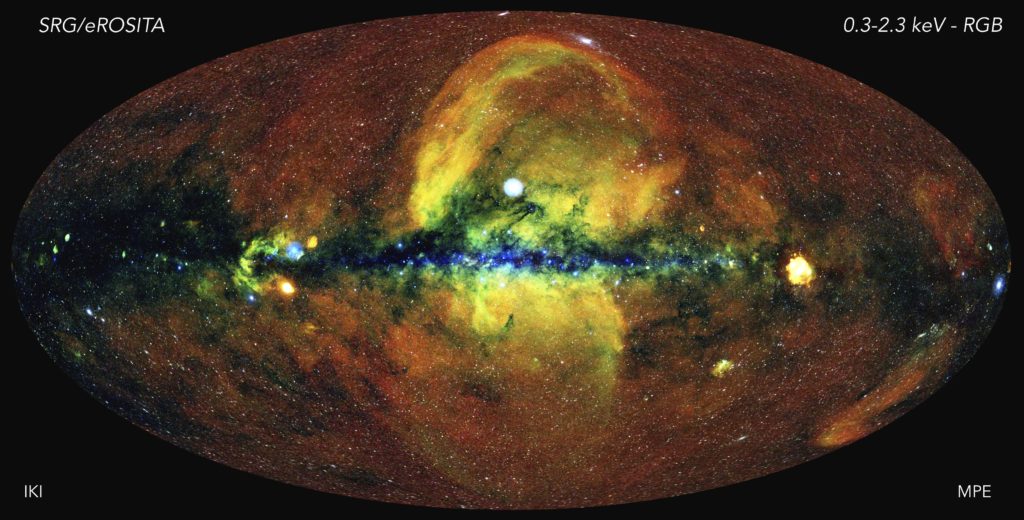Advances in all-sky surveys permit better visualization of the motions and dynamics inside our galaxy. And provide a better understanding of the evolution of the Milky Way.
X-ray all-sky surveys
As noted in this Space.com article, while “optical telescopes are much easier to design than X-ray telescopes … some of the most interesting objects in the Universe don’t emit light at visible wavelengths and therefore remain mostly hidden to optical telescopes.”
• Space.com > “German X-ray space telescope captures most complete map of black holes ever” by Tereza Pultarova (July 27, 2021) – eROSITA can see light from objects which took 7 billion years to reach its detectors.
(quote) The first science from the 2019 eROSITA space observatory [entire sky-survey] is here. … revealing more than 3 million newfound objects in less than two years. … Previous X-ray telescopes … such as ESA’s XMM Newton, or NASA’s Chandra X-ray Observatory, could only observe rather small sections of the sky [but deeply] in one go.
“For the first time, we have an X-ray telescope that can be used in very similar ways as the large field optical telescopes that we use today,” Merloni [mission’s senior scientist] said. “With eROSITA, we cover the entire sky very efficiently and can study large-scale structures, such as the entire Milky Way.”
… the catalogues contain information about 3 million sources of X-ray radiation — black holes, neutron stars and galaxy clusters. About 77% of those sources are distant black holes in other galaxies, 20% are neutron stars, stars and black holes in the Milky Way. The remaining 3% are galaxy clusters, he added.

Johannes Buchner
CC BY-SA 4.0
File:SRG-eROSITA all-sky image.jpg
Created: 19 June 2020
References
• European Space Agency’s Gaia (2013)
• European Southern Observatory’s ground-based Very Large Telescope
• European Space Agency’s XMM Newton X-ray space observatory (1999)
• Chandra X-ray Observatory (1999)
Related posts
• The Milky Way’s shape — a peculiar disk
• Yes, Virginia, there is a black hole in the center of our Milky Way
• Levels of understanding – what are X-rays?
• Celebrating X-Ray Astronomy — Chandra

Processing of Sloan Digital Sky Survey data revealed that dwarf galaxies likely contain black holes, thereby revising census of these objects. Energetic patterns and “Iron 10” emissions and X-rays.
• Quanta Magazine > “Tiny Galaxies Reveal Secrets of Supermassive Black Holes” by Charlie Wood, Staff Writer (March 14, 2022) – Dwarf galaxies weren’t supposed to have big black holes. Their surprise discovery has revealed clues about how the universe’s biggest black holes could have formed.
Our everyday experience belies the frame of reference for the Earth’s high velocity through the cosmos.
• NASA > APOD > “CMB Dipole: Speeding Through the Universe” (April 4, 2022)
Another all-sky survey mission for 2024 ff – a near-infrared space observatory will create a 3-D map of the entire sky.
• The Caltech Weekly 8-18-2022 > Caltech News > “A Test Chamber for NASA’s New Cosmic Mapmaker Makes a Dramatic Entrance” (August 16, 2022) – Unlike any previous map, it will provide images of individual objects as well as a light spectrum for every point in the sky.
Credit: Wiki (Creative Commons)
Interferometry and multi-wavelength collaborative astronomy in the news – a powerful radio telescope (array) gets even better.
• Space.com > “Major radio telescope ‘levels up’ to get unprecedented views of the early universe” by Robert Lea (Oct 25, 2022) – The upgraded antenna array allows astronomers to zoom in on cosmic objects and investigate them in finer detail [~detect a cellphone from over 310 miles (500 km) away].